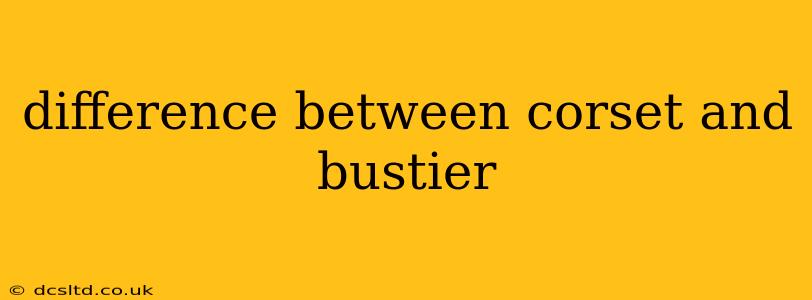The terms "corset" and "bustier" are often used interchangeably, leading to confusion. While both are undergarments designed to shape the torso, key distinctions exist in their structure, purpose, and historical context. Understanding these differences is crucial for anyone interested in corsetry, fashion history, or simply choosing the right garment for their needs.
What is a Corset?
A corset is a close-fitting, structured garment worn to shape the torso. Historically, corsets were designed to dramatically cinch the waist, creating an hourglass silhouette. They are typically made from strong, rigid materials like coutil (a heavy woven fabric) and boning (rigid inserts like whalebone, steel, or plastic). The boning provides the support and structure necessary for significant waist reduction. Corsets often feature a complex system of lacing in the back, allowing for adjustability and a customized fit. Modern corsets retain many of these features but often prioritize comfort and flexibility over extreme waist reduction.
What is a Bustier?
A bustier is a close-fitting, structured garment that resembles a corset but is generally less constricting and more focused on aesthetic appeal. Bustiers often feature less boning than corsets and may lack the extensive lacing system. They are typically made from softer, more pliable materials like satin, silk, or lace and are often designed to be worn as outerwear or with other garments. While some bustiers may offer slight shaping, their primary function is to enhance the appearance of the bust and torso rather than significantly altering the body's shape. Think of a bustier as a more decorative and less restrictive version of a corset.
What are the Key Differences Between a Corset and a Bustier?
Here's a table summarizing the key distinctions:
| Feature | Corset | Bustier |
|---|---|---|
| Structure | Highly structured, rigid boning | Less structured, less boning |
| Material | Typically coutil, strong fabrics | Often satin, silk, lace, softer materials |
| Purpose | Primarily shaping, waist reduction | Primarily aesthetic, enhancing appearance |
| Waist Reduction | Significant potential for waist reduction | Minimal or no waist reduction |
| Lacing | Usually features extensive back lacing | May have lacing or other closure methods |
| Wear | Typically undergarment, can be outerwear | Often worn as outerwear or with other garments |
How Tight Should a Corset Be?
This is a crucial question, often asked by those new to corsetry. A corset should be snug but not painfully tight. You should be able to comfortably breathe and move around. The feeling of compression should be firm but not restrictive. Never force yourself into a corset that feels too tight, as this can cause discomfort, restrict breathing, and potentially lead to injury.
Can a Bustier Be Used for Waist Training?
Generally, no. Bustiers are not designed for waist training. Their lack of rigid structure and significant boning makes them unsuitable for the level of compression required for waist reduction. Attempting to use a bustier for waist training could lead to discomfort and might not achieve the desired results.
Are There Different Types of Corsets and Bustiers?
Yes, both corsets and bustiers come in various styles and designs. Corsets can range from long, overbust styles to shorter, underbust versions. Bustiers also come in many variations, including those with different necklines, straps, and embellishments. The specific design often depends on the era, fashion trends, and personal preferences.
In conclusion, while the terms "corset" and "bustier" are sometimes used interchangeably, understanding their nuanced differences is crucial. A corset is a highly structured garment designed for shaping, while a bustier is a less restrictive garment that prioritizes aesthetics. Choosing the right garment depends on your desired level of shaping, comfort preferences, and intended use.
